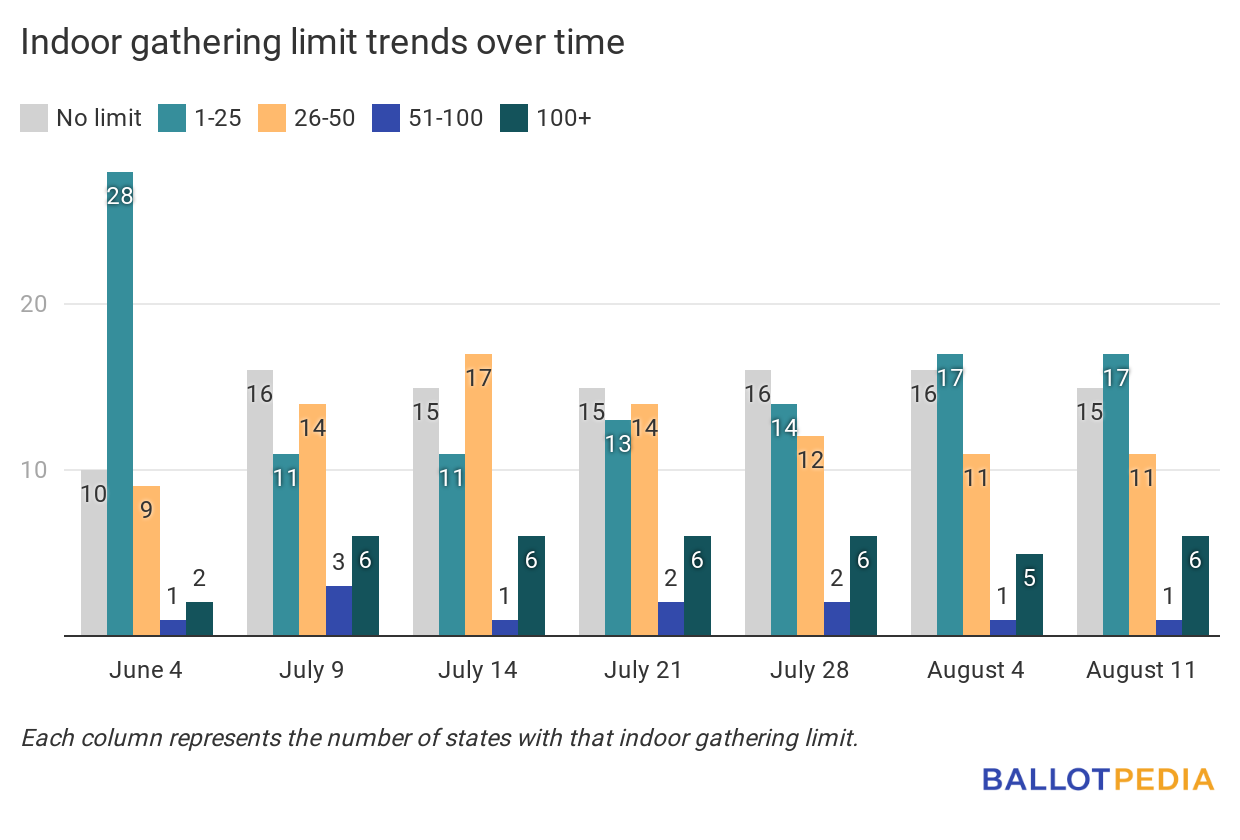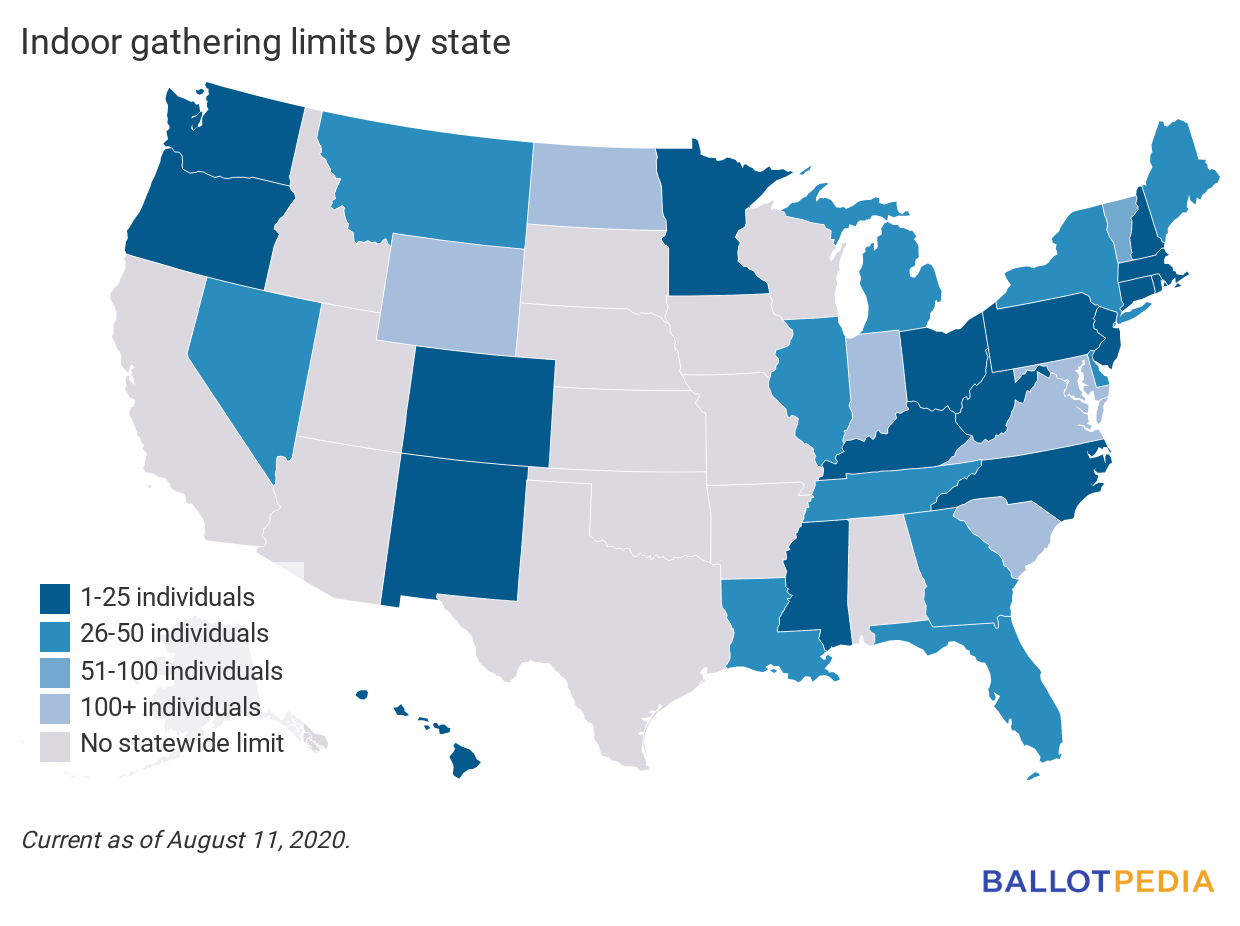Each day, we:
Want to know what happened yesterday? Click here. We'll complete our summaries of all 50 state public school reopening plans on Aug. 17. What do you think we should cover next? What topics do you want more information about—or less? Or do you think there's something we should look at once again? We want to know what you think! Simply reply to this email with your suggestions and comments. We look forward to hearing from you! Since our last editionWhat is open in each state? For a continually updated article on reopening status in all 50 states, click here. For our last edition, click here.
Tracking industries: Indoor gathering limitsAll 50 states are reopening in some way. Here, we give the status of one industry or activity across the states. Today’s question: what is the indoor gathering size limit in each state? We last looked at indoor gathering size limits in the August 4th edition of the newsletter. Since then, South Carolina instituted an indoor gathering size limit of 250 individuals.
|
|||||||||||||||||||||||||||||||||||||||||||||||||||||||||||||||||||||||||||||||||||||||||||||||||||||||||

This is an in-depth summary of two state plans to reopen public K-12 schools for the 2020-2021 school year. New Jersey’s The Road Back: Restart and Recovery Plan for EducationOn June 26, Governor Phil Murphy and Department of Education Commissioner Lamont O. Repollet released The Road Back: Restart and Recovery Plan for Education, the state’s guidelines for reopening public schools for in-person instruction in the fall. Commissioner Repollet said, “New Jersey educators and families did an amazing job over the past three months implementing remote learning, even with relatively little time for planning. That effort was nothing short of heroic. However, too many parents feel that remote-only instruction isn’t working for their child, and too many children are falling behind. It is becoming abundantly clear that children need to return to a school environment in some capacity, and we need to do so safely. This is a matter of educational growth, and it’s a matter of equity.” In July, Murphy issued additional guidelines, clarifying that each district was required to offer remote-only options for instruction and that each district would be responsible for designing and implementing its plan for remote learning. Several teachers’ unions in the state, including those in Paterson and Essex County, have called for public school openings to be delayed for in-person instruction. The New Jersey Principals and Supervisors Association has also called for statewide remote instruction to start the school year. There is no statewide date for schools to begin instruction in New Jersey; each district sets its own specific start date. According to Ed Week, public schools in New Jersey typically start the academic year in late August to early September, with specific dates varying by district. Schools in New Jersey were closed for in-person instruction on March 18, 2020, and remained closed for the remainder of the year. ContextNew Jersey is a Democratic trifecta. The governor is a Democrat, and Democrats have majorities in both chambers of the state legislature. The state became a Democratic trifecta in 2018. The following tables show public education statistics in New Jersey, including a rank comparing it to the other 49 states. Rank one is the highest number of each figure, rank 50 is the lowest. All data comes from the Common Core of Data provided by the National Center for Education Statistics.
DetailsDistrict reopening plans Districts are required to develop and submit their own specific plans that meet or exceed the state’s reopening guidelines. Districts are encouraged to share their reopening plans with the public at least four weeks before the beginning of the school year. In-person, hybrid, and online learning New Jersey’s reopening guidelines specify that districts must account for resuming in-person instruction in their reopening plans. The guidance Murphy issued in July specified that each district should also offer students an option for fully remote instruction. Each district determines its schedules. The state’s reopening guidelines offer some models for in-person, hybrid, and online learning: Systems which support in-person, fully virtual and hybrid learning should serve as the foundation for the development of a strategic plan for delivering instruction to students in alignment with the following core guiding principles:
Mask requirements Educators, staff members, and visitors will be required to wear a mask or face covering throughout the day unless they are unable due to a health reason. Students are required to wear a face covering when they cannot maintain six feet of distance and are encouraged to wear masks throughout the day. In-person health recommendations and requirements Schools are expected to offer the maximum amount of social distance possible, with the recommendation that students are placed at least six feet apart in classrooms. Where this is not possible, the guidelines recommend physical barriers. Each district is also required to adopt a disinfecting policy, place directional markers in high-traffic areas, and adopt a policy for screening students and employees for symptoms and exposure history. School districts must adopt a policy for screening students and employees upon arrival for symptoms and history of exposure. Policies must include the following:
Districts are also required to develop protocols for positive tests or contact with those who have tested positive for COVID-19. These protocols must include isolation of the individual, notification of local health officials, and contact tracing. Students can still eat lunch in the cafeteria, but social distancing is still expected and lunch times should be staggered to allow for minimal student contact. Recess and gym are also permitted with size limits. Indoor school sports are not permitted, but outdoor school sports are allowed. Transportation and busing requirements and restrictions School buses are recommended to maintain a six-foot social distance between students. If six feet of social distance is not possible on transportation, students are required to wear face coverings. The guidelines also recommend having students fill in the back rows of the bus first and progress forward. Students exit the bus in the opposite fashion to limit physical interaction among students. Bus drivers are required to wear face coverings and follow sanitizing protocols in line with other staff members. ResponsesIn July, The Essex County Education Association, which represents 12,000 teachers in one of the largest districts in the state, called for schools to open with fully remote instruction. The group’s president, Anthony Rosamilia said:
The Garden State Coalition of Schools, a nonpartisan education advocacy group, applauded the state’s reopening guidelines, saying:
New York's Recovering, Rebuilding, and RenewingThe New York State Education Department released its school reopening guidance on July 13. Interim Commissioner Shannon Tahoe said, “The guidance encourages community involvement and allows for flexibility so that districts and schools in every corner of the state can assess their unique situation and develop a plan that best meets the needs of their students.” Gov. Andrew Cuomo (D) said, “It's purely on the numbers, purely on the science." At that time it was unclear if all schools would be allowed to reopen. Gov. Cuomo held a press conference on Aug. 7, where he announced all school districts in the state were authorized to open, as long as the rate of positive tests in the district remained below 5 percent. The decisions about in-person learning were left to each district. New York does not have a statewide date for public schools to reopen. Each district is required to hold three online discussions with parents regarding their plans by August 21. According to EdWeek, public schools in New York traditionally start the academic year in late August to early September. On March 16, Gov. Cuomo closed schools for two weeks beginning March 18. On March 27, Cuomo extended the closure through April 15. He extended it again on April 6 to go through April 29, and on April 16 to go through May 15. The governor closed schools for the rest of the academic year on May 1. ContextNew York is a Democratic trifecta. The governor is a Democrat, and Democrats have majorities in both chambers of the state legislature. The state became a Democratic trifecta in 2019. The following tables show public education statistics in New York, including a rank comparing it to the other 49 states. Rank one is the highest number of each figure, rank 50 is the lowest. All data comes from the Common Core of Data provided by the National Center for Education Statistics.
DetailsDistrict reopening plans Each school district had until July 31 to submit plans to the New York State Department of Health for three different learning models–all in-person, all remote, and a hybrid of the two. Each plan had to detail how districts would meet state requirements for each model. The plans are required to be made publicly available online. In-person, hybrid, and online learning The decision to reopen schools for in-person learning has been left up to individual districts, and each district has been required to post online plans regarding testing, contact tracing, and remote learning. Cuomo is also requiring districts to host information sessions with parents and the community to discuss their plans. Mask requirements Schools are required to provide face coverings to employees, and to have them available to students if they forget their own. Everyone in a school and on school grounds is required to wear cloth face coverings in the following situations:
In-person health recommendations and requirements For reopening to in-person instruction, the state provides detailed recommendations on health checks, hygiene practices, social distancing, PPE and face coverings, managing ill persons, and cleaning and disinfecting. Additionally, schools are required to meet a large number of conditions to reopen, including:
Transportation and busing requirements and restrictions Requirements and considerations for transportation and busing include:
Additional activityIn this section, we feature examples of other federal, state, and local government activity, as well as influencers relevant to recovering from the pandemic.
|
|||||||||||||||||||||||||||||||||||||||||||||||||||||||||||||||||||||||||||||||||||||||||||||||||||||||||
Documenting America's Path to Recovery: August 11, 2020
By



